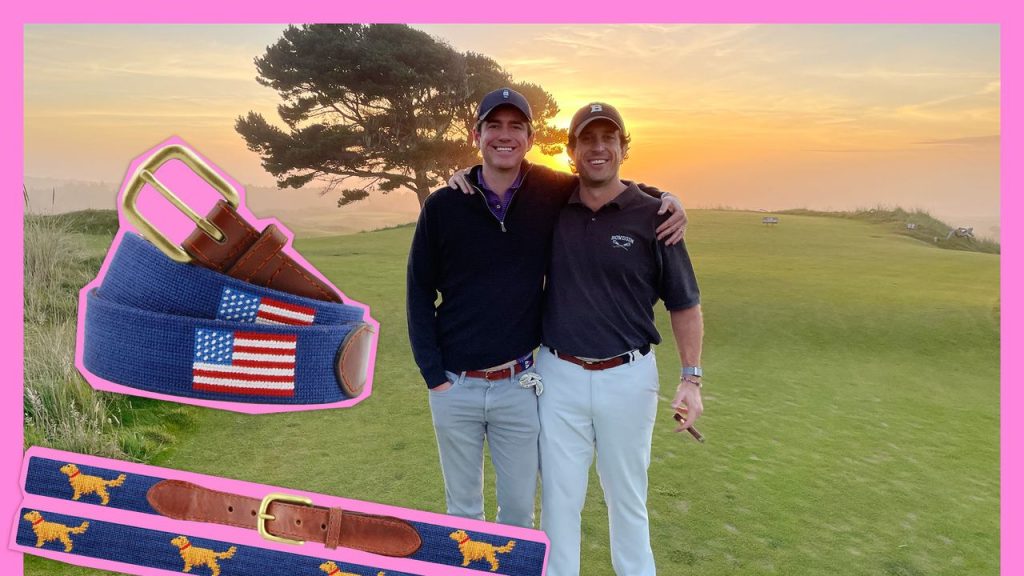About two years in, “there was so much interest from the Southern men’s stores, particularly, saying, ‘Look, I’m selling your belts well, but, you know, I could really sell a Clemson or a Georgia or University of Texas belt very, very well,’” Carter recalls.
They built a book of business, proving that selling belts was a cinch, and went back to the schools for the licenses. Colleges, Greek organizations, professional sports franchises, bands, and more gave permission for the company to commit their emblems to needlepoint.
Now Smathers & Branson offers not only belts, which can be customized with a multitude of emblems, but also embroidered key tags, hats, leather can coolers, and more. Though Bowdoin didn’t have a Greek system, the pair liken their college living situation to a frat house, touting the belts’ appeal amongst golfers, campus dwellers, and more, with tales of men showing off their belt collections.
Branson recalls “watching [the belt trend] explode at the University of Georgia and Texas,” to name just two schools. “It’s just mind-blowing, the next level of enthusiasm and passion there is for the college experience everywhere.”
Though needlepoint belts remain an eye-catching niche accessory, their prevalence in the preppy-leaning sartorial displays of campus bros is unsurprising, Articles of Interest podcast host and creator Avery Trufelman tells VF. Trufelman produced a full season of her show around the idea of prep, attributing the style’s prevalence to its being a “sweet spot in the American dream.” In the US, there’s no formal class system, no monarchy. Dressing preppy, a trend that Trufelman says evolved from the casual style of Princeton students who would play tennis and then—gasp!—stay in their tennis clothes, rather than spiff up, is an accessible way to signal social rank, whether real or aspirational, and belonging.
Trufelman points to a certain IYKYK aspect of classic preppy brands, like J. Press, which never displays logos and instead may use a school’s colors in an article of clothing, for instance, as a sort of dog whistle for other alums to pick up on. The Smathers & Branson cofounders, too, call out that their pieces show the wearer’s choice of emblems, rather than any brand logo of their own, allowing the company to be both a golf brand and a tailgating brand, for example.
Young women preparing for sorority recruitment are often advised to incorporate personal pieces into their looks to help them stand out; similarly, Trufelman points to items like the belts as a social bridge.
“That’s the fundamental thing about preppiness: It’s an institutional look. It’s about belonging,” she says. “Even if you don’t belong, it’s a way to look like you belong. It’s a way to look like you went to these schools. It’s a way to look like you go to these clubs.”
And though Smathers & Branson belts aren’t necessarily made by a college girlfriend, they are hand-stitched and heirloom-quality. Branson shows off a key tag that he’s carried for some 20 years, featuring a stitched depiction of a golden retriever, the breed of his childhood dog. “This is a sample, I think, from one of the first batches that we did,” he says. “It has been really loved.”
The idea that a young man may be able to inherit his father’s needlepoint belt the same way he might wear a luxury watch passed down to him is part of the company’s success with the preppy set.
“The men’s space that we operate in doesn’t change [in the same way as] high-end women’s fashion,” Carter says. “Some of our best-selling patterns, like American flags or dogs, although we do change them from year to year, they don’t change that dramatically. I think that’s the same thing kind of within frat life, and then collegiate stuff, the game-day clothes, they don’t change necessarily.”
“It’s a classic, traditional men’s look that evolves,” Branson adds. “The shape of a khaki pant changes, the fit the guys are wearing different years changes, but the same basic look is consistent. While I don’t think of ourselves as, like, a Greek business necessarily, we fit into that as an element of what that customer, that demographic, has probably worn since the ’60s.”

